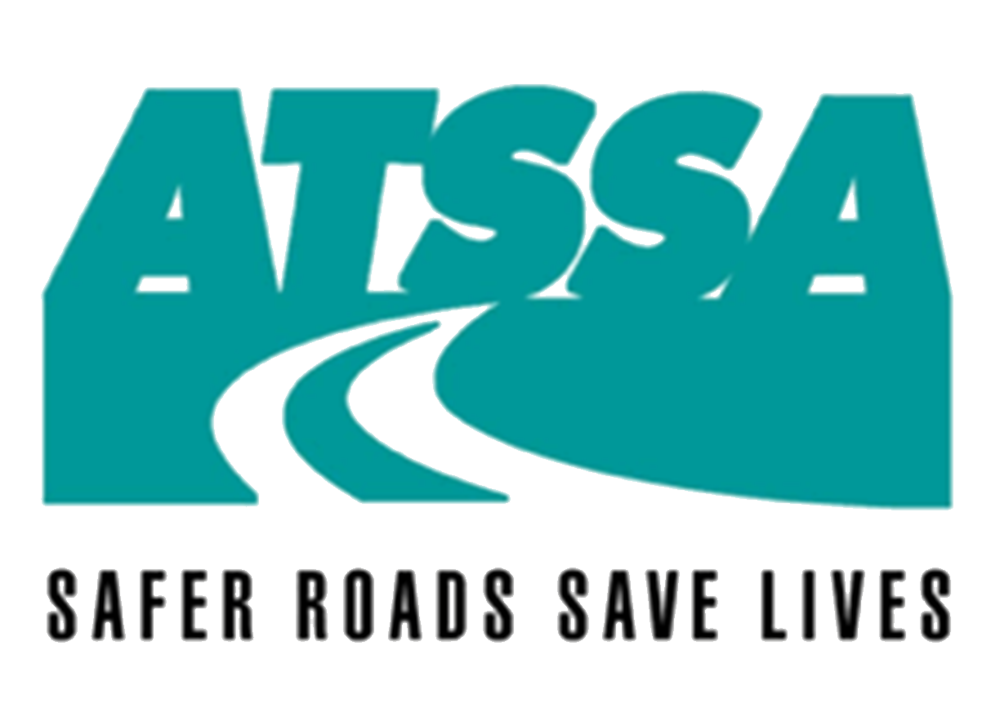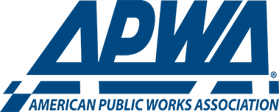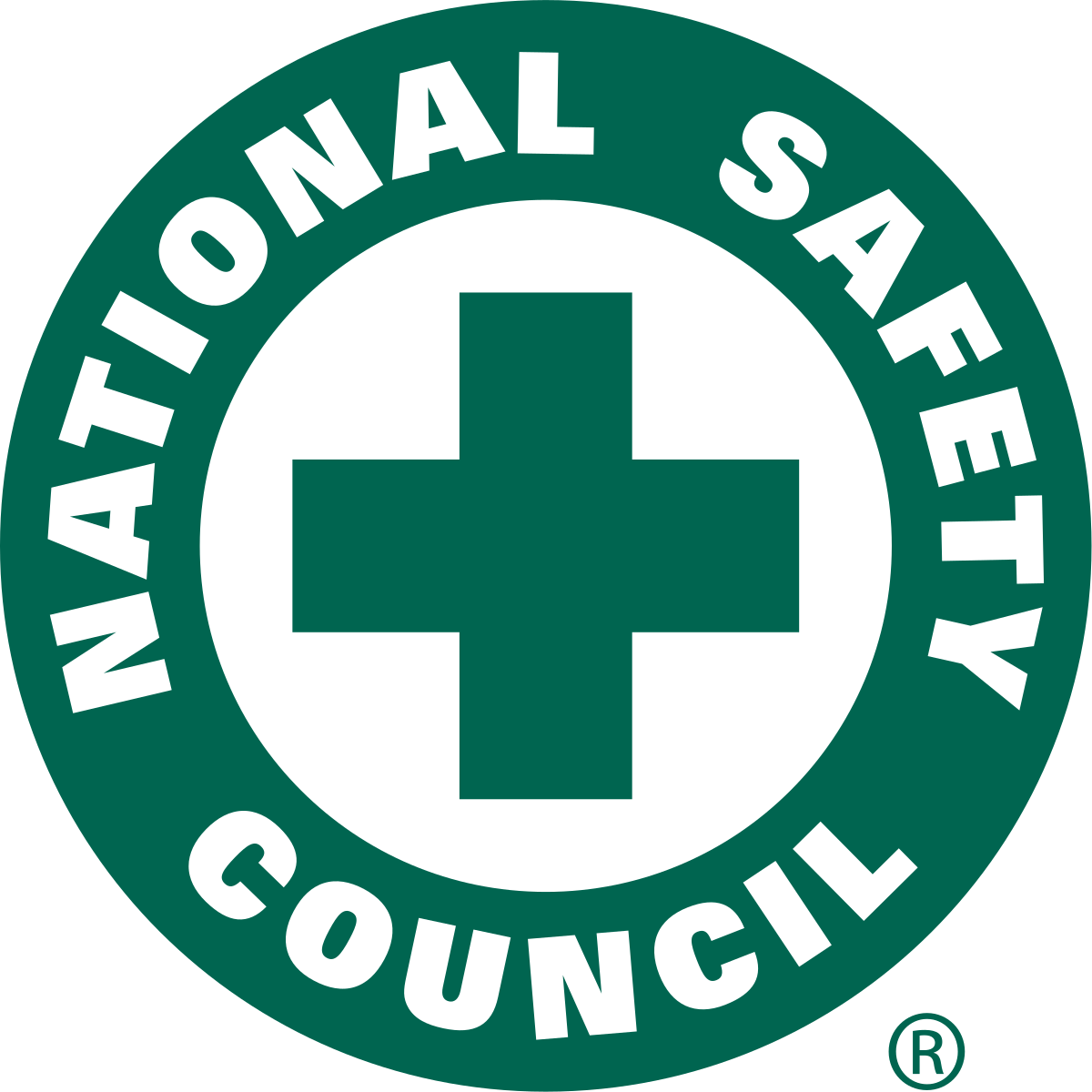Winter and Cold Weather Safety Tips for Construction Workers
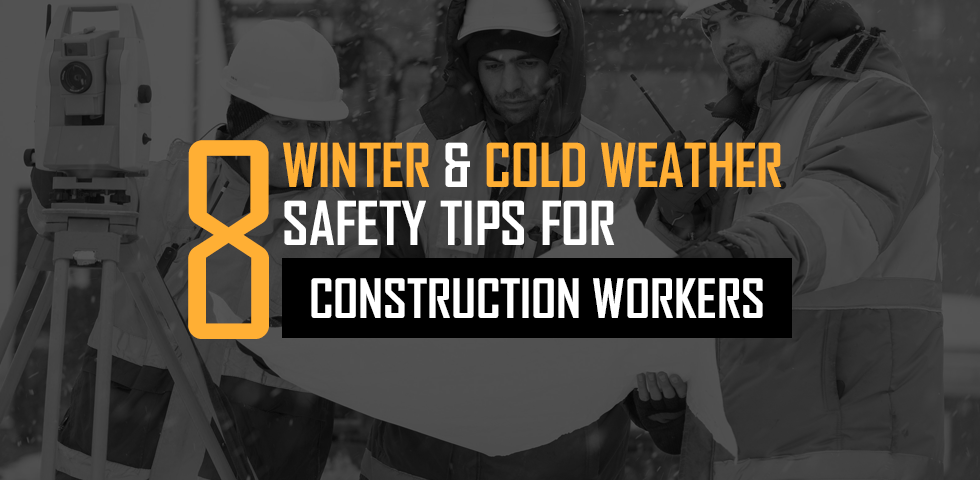
Cooler weather is a welcome relief after working in the summer heat. However, winter weather brings a new set of concerns. Working construction in the winter can be dangerous, especially in the Mid-Atlantic region where temperatures drop into the single digits one day and rise above freezing the next. Melting and refreezing causes extremely slippery conditions. Construction workers need to know how to protect themselves.
Luckily, you can keep a construction business up and running during the coldest time of the year. In this post, we’ll look at everything you need to know about winter construction safety. From the Occupational Safety and Health Administration (OSHA) winter safety tips to construction worker winter clothes, we’ll cover the basics so you and your workers can enjoy a safe and profitable season.
Buy Construction safety gear From D.E. Gemmill
OSHA Cold Weather Safety Regulations
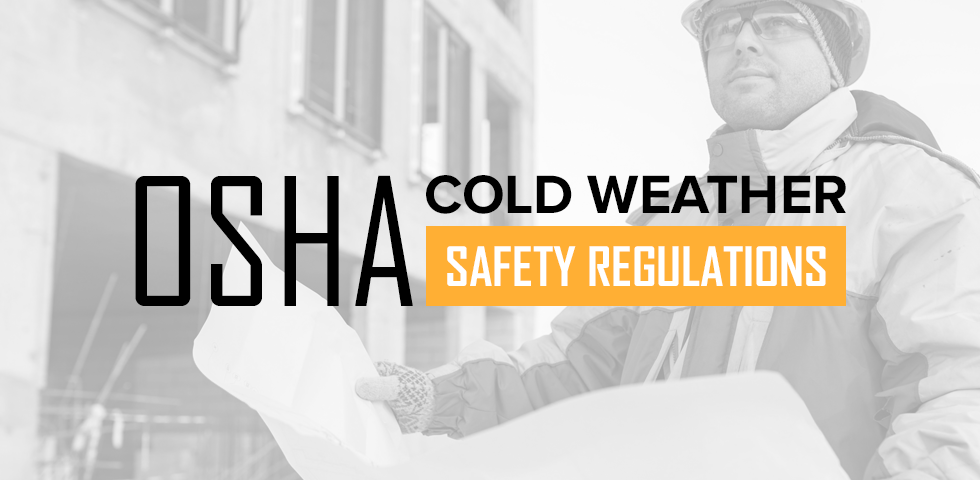
OSHA does not have set standards for employee safety in the winter. However, although there are no OSHA rules for working in cold weather, there are some helpful tips. For winter construction work, OSHA recommends:
- Training: Employers should teach workers how to avoid cold weather-related conditions such as frostbite and trench foot. Training might cover topics such as proper winter clothing and how to recognize a hazard.
- Monitoring: Employers and workers should keep a close eye on their physical conditions to make sure they are not ill. They should also look out for each other.
- Scheduling frequent breaks: Employers should schedule frequent, short breaks throughout the day to give workers a chance to warm up.
- Scheduling work in the afternoon: Employers should schedule work for the warmest part of the day, and avoid scheduling jobs during frigid weather.
- Working in pairs: Workers should use the buddy system or work in pairs. The buddy system allows workers to help each other when needed.
- Providing beverages: Employers should give workers warm, sweet drinks, such as hot chocolate or decaffeinated tea.
- Clearing snow and ice: Employers should clear snow and ice from walkways and work surfaces to prevent trips and falls. If this is not possible, employers can train employees to walk on snow by taking short steps and walking at a slow pace. Managers should also emphasize the importance of proper footwear.
- Using engineering controls: Employers can use radiant heaters or shield work areas from wind to help keep workers warm.
- Preventing falls from elevated surfaces: Employers should avoid scheduling work on rooftops or other elevated surfaces after a snowfall. However, if this is unavoidable, employers should provide fall protection equipment and training. Also, they should make sure ladders are clear of ice and snow and securely in place. Lastly, employers should caution workers to be extremely careful when working next to power lines.
- Providing the right tools: Employers should ensure workers have the right tools to do their jobs properly and safely in winter weather.
It’s worth mentioning that OSHA requires employers to protect workers from known hazards that could cause injury or death. It’s a good idea to keep OSHA safety tips in mind year-round.
Call (717) 747-1391 For Our Safety Gear
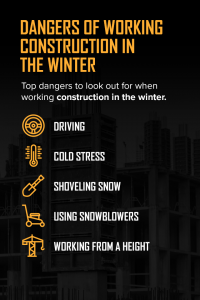
Avoiding Dangers of Working Construction in the Winter
There’s no doubt winter can be a dangerous time of the year for everyone. Construction workers are especially vulnerable to winter-related dangers. However, with the right preparation and training, a construction crew can stay safe and productive in the winter.
The first step to cold weather construction safety is knowing how to identify hazards before they cause harm. Here are the top dangers to look out for when working construction in the winter.
1. Driving
Winter driving can be extremely dangerous. According to the U.S. Department of Transportation (DOT), 24 percent of weather-related vehicle crashes occur on icy, slushy or snowy roads. Every year, more than 1,300 people are killed on roads under these conditions, and over 900 are killed during snowfall or sleet.
Construction workers might have to drive or operate machinery in hazardous winter situations, and anything could happen. For example, a heavy equipment operator might skid on ice in a work zone or lose control and strike a worker. Workers should always wear high visibility winter jackets so other workers can see them at all times. Signage, barriers or cones should be used to help protect workers.
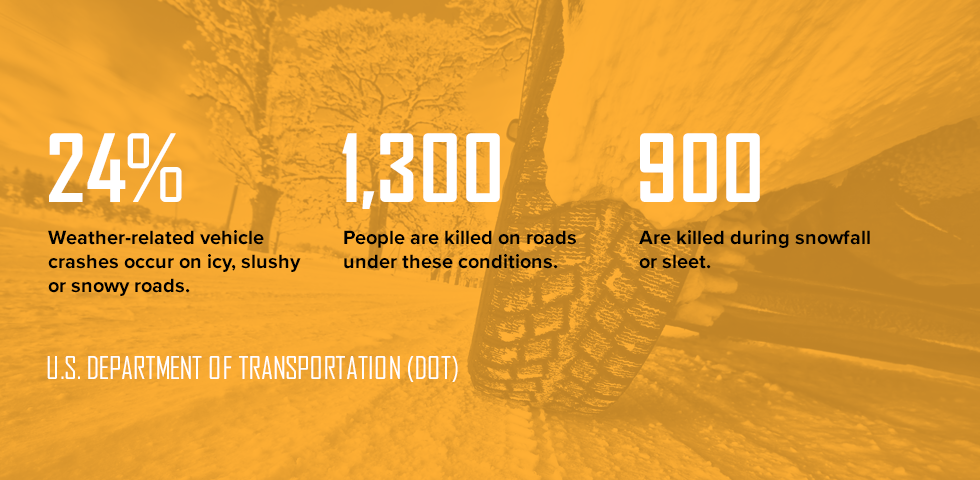
Employers should also train workers to handle machinery and vehicles in snowy conditions. Employees should know how to inspect vehicles every day before work and how to recognize driving-related hazards.
2. Cold Stress
You do not have to live in Antarctica to suffer from cold stress. Some conditions, like hypothermia, can occur in temperatures in the 50s F when wind or rain is present. Cold stress occurs when heat rapidly leaves the body and can lead to illness or injury. Any worker who works outside is at risk of cold stress during the winter. Types of cold stress include:
- Trench foot: Trench foot is a non-freezing injury and can occur in temperatures as high as 60 F. Injury occurs when feet are exposed to wet and cold conditions for prolonged periods because feet lose heat 25 times faster when they are wet. Symptoms of trench foot include reddened skin, pain, swelling, tingling, blisters, leg cramps and numbness.
- Frostbite: Frostbite occurs when the skin freezes and can lead to permanent damage. Symptoms include reddened skin that develops gray or white patches, aching, tingling, loss of feeling and possibly blisters and hardening of the affected area. Frostbite usually affects fingers, toes, the nose or earlobes. Individuals who do not dress properly or who have bad circulation are at higher risk for frostbite.
- Hypothermia: Hypothermia occurs when the body’s temperature drops from 98.6 F to less than 95 F. When a worker is left in the cold too long, their body will lose heat fast and eventually use up its stored energy, resulting in hypothermia. Mild symptoms include uncontrollable shivering and can progress to loss of coordination, confusion, slurred speech, slowed heart rate and breathing. Severe hypothermia can lead to unconsciousness and death.
3. Shoveling Snow
Many of us dread shoveling snow because it’s an exhausting task and puts a lot of stress on the body. Workers can injure themselves while clearing surfaces if they are not careful. Shoveling snow can cause back injuries, exhaustion, dehydration or even a heart attack.
Shoveling snow sends more than 11,000 adults and children to the hospital every year. To prevent an injury, workers should take frequent breaks, push the snow instead of lift it and follow proper lifting techniques. They should also warm up before shoveling.
4. Using Snowblowers
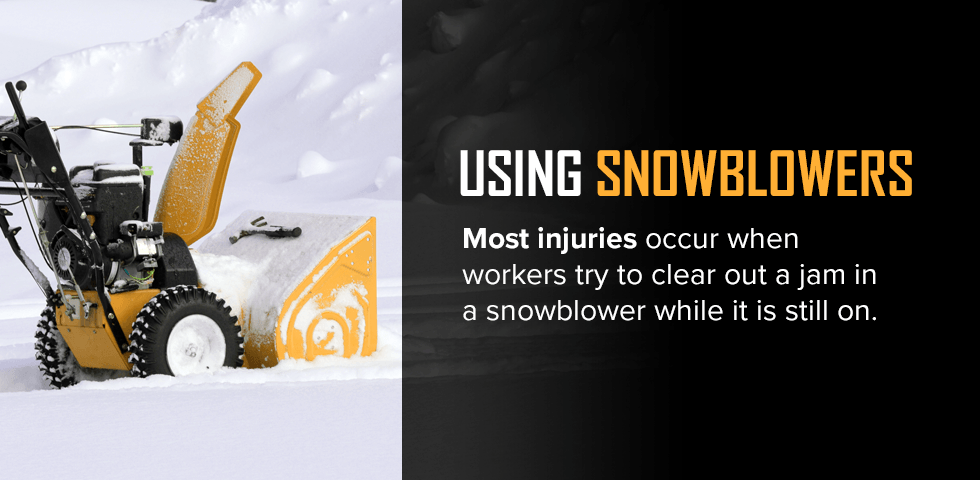
Although snowblowers make snow removal easier than shoveling, they can lead to injuries like electrocution or lacerations if workers are not careful. Most injuries occur when workers try to clear out a jam in a snowblower while it is still on. Employers should remind workers to always turn a snowblower off before clearing a jam, and use a stick to remove material from the snowblower rather than their hand.
5. Working From a Height
Construction workers are at risk of height-related injuries year-round. However, snow and ice make surfaces slippery and increase the risk of a fall. Snow can also conceal sharp objects and other debris. Workers need to be aware of potential hazards such as hidden wires or structurally damaged rooftops.
8 Winter Construction Safety Tips
Construction workers and managers can overcome the safety challenges of wintertime work and keep things running smoothly by staying alert, looking for hazards and keeping the following tips in mind.
1. Wear Cold Weather Construction Gear
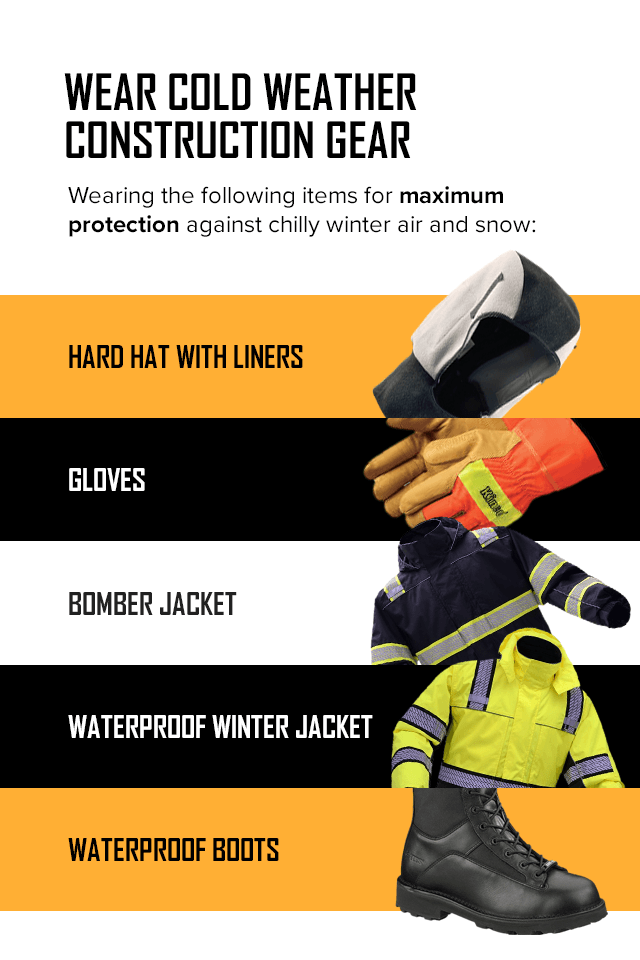 One of the best and easiest ways to protect yourself from cold weather injuries is to wear the right gear. At D.E. Gemmill Inc., we offer high-quality cold weather clothing to keep construction workers warm and visible at the work site. We recommend wearing the following items for maximum protection against chilly winter air and snow:
One of the best and easiest ways to protect yourself from cold weather injuries is to wear the right gear. At D.E. Gemmill Inc., we offer high-quality cold weather clothing to keep construction workers warm and visible at the work site. We recommend wearing the following items for maximum protection against chilly winter air and snow:
- Hard hat with liners: Workers should wear hard hats to protect them from falling objects and head injuries if they slip and fall. Liners can help trap heat and keep them warm. Up to 40 percent of body heat can be lost if the head is exposed. Our Occunomix Classic Full Face Hard Hat Liner provides full protection against intense wind chills. This liner features a nose guard, mesh mouth, and heavyweight fleece to help prevent frostbite and hypothermia. Our Occunomix Hard Hat Classic Mid-Length Fleece Liner fits snug under a hard hat, helps trap heat and keeps the head and neck warm on a winter day.
- Gloves: Hands are especially vulnerable to frostbite when working in the cold. Gloves are a must-have for construction workers, but not just any glove will do. Workers should wear gloves that allow them to handle tools easily, but which also provide the cold protection they need. Our Radwear Cold Weather Gloves are perfect for working in freezing temperatures. These gloves are waterproof, thermal-lined and feature reflective knuckle straps for visibility. For genuine leather palm and fingers, our Kinco Cold Weather Pigskin Gloves feature thermal lining to keep hands warm and a reflective strip across the knuckles.
- Bomber jacket: A solid bomber jacket is a way to close in heat and provide excellent visibility. Our 3-in-1 Class 3 Winter Bomber with a segmented reflective stripe is a great choice for construction workers. This highly durable jacket is tough against winter weather and challenging jobs. Resistant to tears, snags and punctures, this jacket is also waterproof and features a removable fleece inner lining with reflective trim and stripes on the exterior. With pockets in all the right places, this coat is made for efficiency on a bitterly cold day.
- Waterproof winter jacket: A waterproof winter jacket is essential for preventing cold stress and staying warm in the winter. Wet skin loses heat much faster than dry skin, so workers want to stay as dry as possible. When you add reflective material to a waterproof jacket, you get optimum safety. Our Class 3 jackets offer the highest visibility in low-light conditions and may be the safest choice for winter work.
- Waterproof boots: To help prevent frostbite and other injuries, workers should wear slip-resistant waterproof boots like our Bates Durashock Gore-Tex Boots and double up on sock layers. Workers should avoid wearing cold steel tip boots in the winter. A common cause of frostbite is wet feet, so wearing waterproof boots should be a priority.
OSHA recommends wearing at least three layers of loose-fitting clothing – an inner layer of wool, silk or polypropylene to keep out moisture, a middle layer of wool or polypropylene to provide insulation, and an outer wind and rain protective layer that allows some ventilation.
Workers should be careful not to wear cotton, which will pull heat from the body when it gets wet. Doubling up on socks can also allow workers to remove a pair if their feet get damp to help reduce risks.
Whichever type of protective gear you use, you’ll want to ensure visibility and loose-fitting layers. Wearing bright, reflective clothes is always important, but the early sunset of winter can mean working more in the dark, so high-visibility gear is especially useful. The layers should be loose-fitting, as tight clothing can affect blood circulation and make it harder for blood to reach extremities.
Winter clothing is one of the easiest and most important ways to protect workers from cold weather. Make sure appropriate cold weather construction gear is available to workers during winter jobs.
2. Prepare for the Effects of Low Temperatures Freezing and Thawing Effects on Work
Construction workers need to consider the effects of freezing and thawing when at the worksite because temperature changes can lead to dangerously slippery roofs, decks and other surfaces. Ice often forms after snow melts and refreezes again, and this can happen on a variety of surfaces.
Some roof materials, such as polyvinyl chloride (PVC) are especially dangerous to walk on in slippery conditions. Workers and managers must evaluate the situation and plan accordingly to prevent an accident.
Many tools and substances will also react poorly to cold temperatures. Fluids for work machinery, like lubricants and oils, can start to congeal in low temperatures. You may need to choose fluids or additives that are rated for cold weather to avoid their damaging effects. Be careful when working with cold batteries, which can cause extensive damage or even explode. Freezing temperatures are also tough on hoses and wires, so warming up your machinery before using it can help it adjust without breaking.
Cold weather can also significantly affect the setting, drying and curing processes of many materials, like concrete, drywall and paint. Check the requirements for your materials to ensure the temperatures allow them to set appropriately.
3. Inspect Worksites
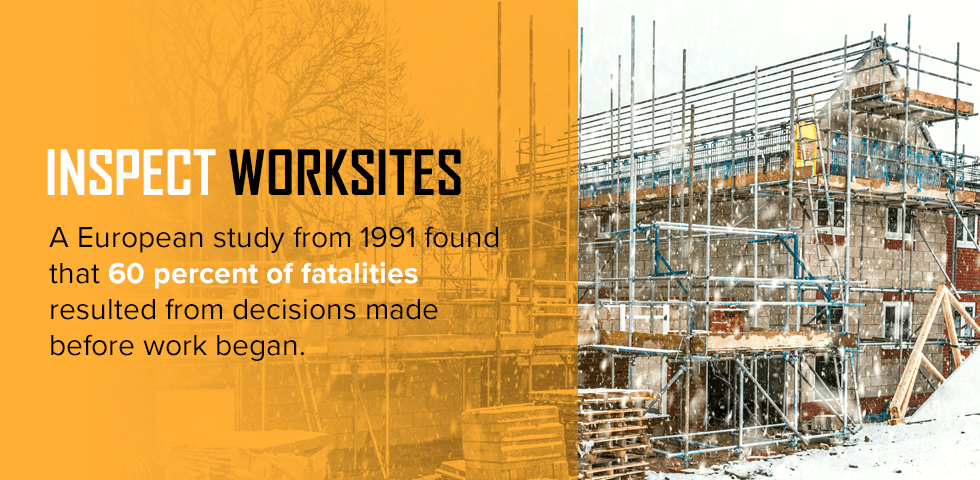
A European study from 1991 found that 60 percent of fatalities resulted from decisions made before work began. Many hazards are recognizable, and employers should inspect the worksite before each shift to look out for dangers such as slippery surfaces or fallen power lines. They should also make sure first aid kits and heated break areas are close by.
With that said, not all hazards are visible. Dangerous sharp objects or other debris can become hidden beneath snow or ice. Managers should look at each task and ask themselves the following questions:
- What can go wrong?
- How could it happen?
- What other factors might contribute to an accident?
- How likely is it that the accident will occur?
- What are the consequences?
Before work begins, a worksite should be cleared of snow and ice. De-icing machines and plows can make quick work of many snow removal tasks. It’s especially critical to ensure there are no walkways, scaffolds, stairs or other platforms with ice or snow on them. Incorporate extra time for these tasks into your schedule to avoid rushing the job.
4. Inspect Work Vehicles
Winter weather takes a toll on vehicles and equipment, so each piece must be inspected before use. Also, equipment should be warmed up before use to avoid equipment damage. OSHA recommends checking the following:
- Brakes and brake fluid levels
- Cooling system levels
- Battery charge
- Alternator belt condition
- Clean electrical connections
- Engine
- Exhaust system is free of leaks
- Tires have proper tread depth and are in good condition
- Oil is at proper levels
- All lights, defrosters and windshield wipers are clear, clean and in good condition
Workers should avoid using equipment that does not have an enclosed cab. Employers should equip all vehicles with emergency kits that include items such as sleeping bags, flares, water and scrapers.
5. Look out for Cold Weather Health Conditions
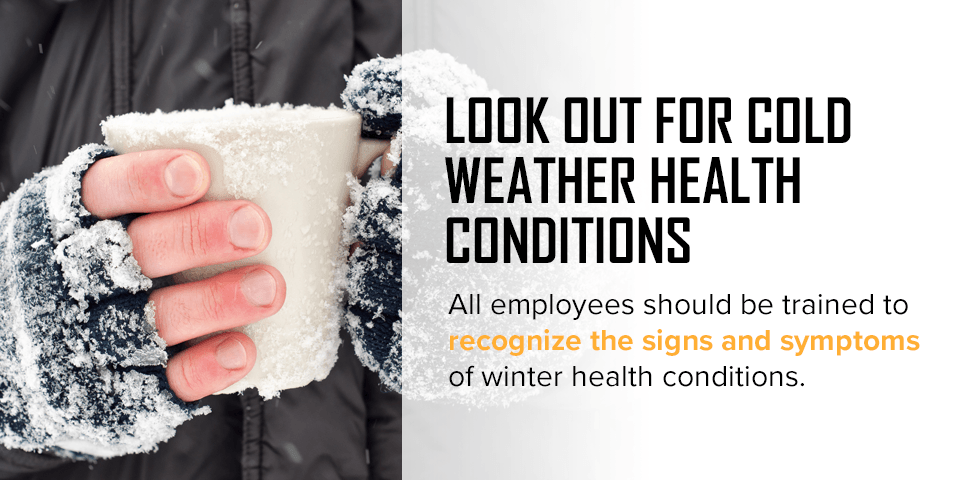
All employees should be trained to recognize the signs and symptoms of winter health conditions. If they know what to look for, they will know when to get help. Also, managers should monitor employees, especially those at risk for cold stress. Risk factors for cold stress include hypertension, hypothyroidism and diabetes.
6. Take Breaks in Heated Areas
Workers want to limit exposure to the cold as much as possible. Employers should provide a heated area such as a trailer or tent to take frequent breaks and warm up. Employers should also encourage workers to change wet clothes and drink warm beverages in the heated area. Break time is the perfect opportunity to check for signs of frostbite or hypothermia too. As always, employers and workers should use heating devices safely.
7. Stay Hydrated
Staying hydrated is always essential on the job, and wintertime is no exception. Workers should drink warm beverages or water, but avoid coffee or anything with caffeine or alcohol. Even though a hot cup of coffee feels great on a cold day, caffeine is a diuretic which causes water loss and increases dehydration. Dehydration can lead to hypothermia. Alcohol increases heat loss and should also be avoided. Individuals with hypothermia should drink warm sugar water.
8. Monitor Weather Reports Closely
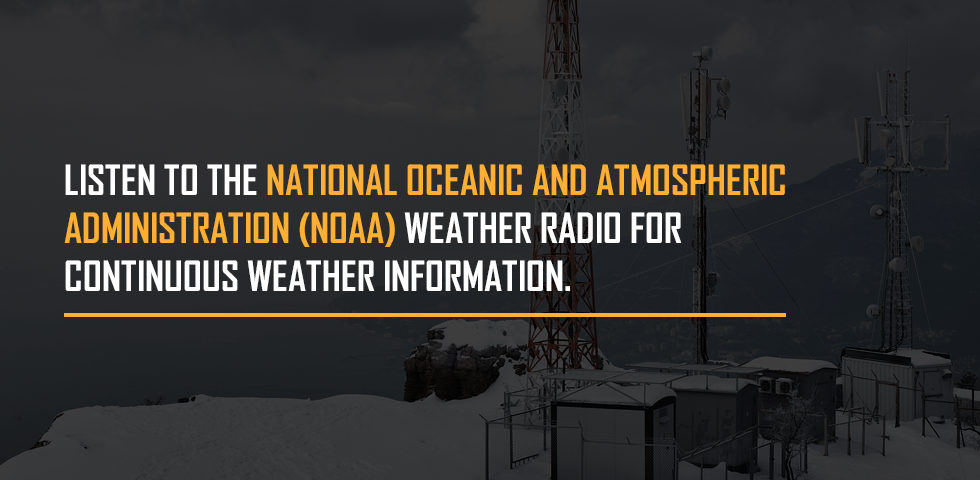
Construction managers need to pay attention to wind chill advisories to prevent cold stress among workers. They can listen to the National Oceanic and Atmospheric Administration (NOAA) Weather Radio for continuous weather information. Here are important terms to help with planning:
- Blizzard warning: Issued for strong wind at 35 mph and snow creating low visibility persisting for at least three hours.
- Wind chill advisory: Issued when prolonged exposure can be hazardous.
- Wind chill warning: Issued when several minutes of exposure is hazardous.
- Winter storm warning: Issued when winter weather is in the form of heavy snow, freezing rain or sleet and is occurring or on the way. Usually issued 12 to 24 hours beforehand.
- Winter storm watch: Warns of a possible blizzard or heavy snow, and is usually issued 12 to 48 hours before a storm.
- Winter weather advisories: Could lead to a dangerous situation if precaution is not taken as a result of accumulated snow, ice, sleet or freezing rain.
Besides listening to the NOAA weather radio, employers can also refer to the chart developed by the American Conference of Governmental Industrial Hygienists. Their chart provides recommendations for scheduling breaks within a four-hour shift.
For example, when there are 5 mph winds and a temperature of negative 35 to 39 F, workers should take five breaks over a four-hour shift and work no more than 30 minutes at a time. At the same temperature with 10 mph winds, no non-emergency work should be done. Conversely, workers can work nearly twice as long — 55 minutes — in 5 mph winds if the temperature is negative 25 to 29 F and only need three breaks over a four-hour shift. As you can see, wind makes a big difference when it comes to comfort and safety. So, even though the Mid-Atlantic region rarely dips below zero, employers should keep in mind the need for frequent breaks.
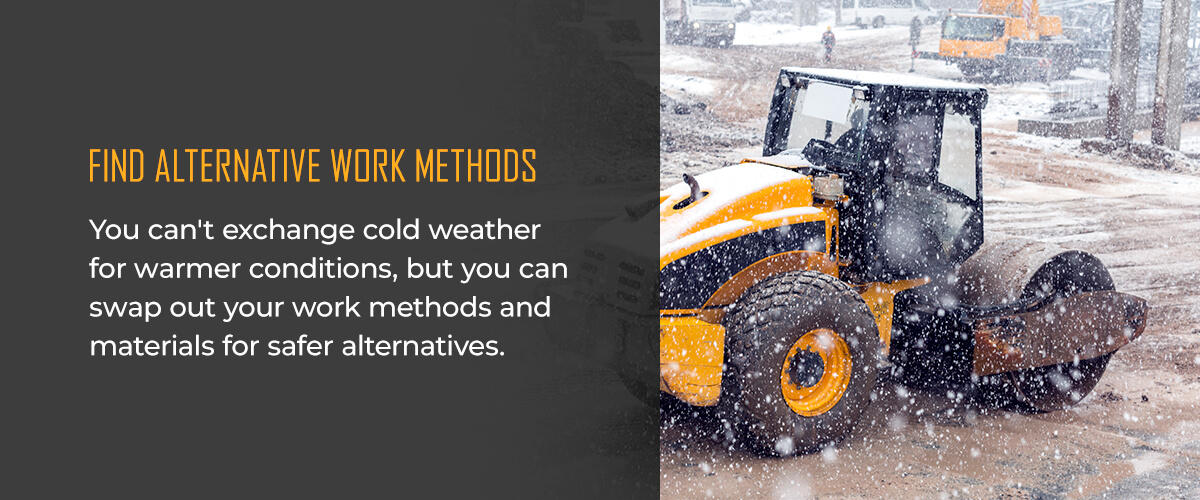
9. Find Alternative Work Methods
You can’t exchange cold weather for warmer conditions, but you can swap out your work methods and materials for safer alternatives. Instead of using slippery ladders, workers could turn to enclosed aerial lifts for added safety. If heavy machinery is often used, a heated cabin can provide a warm substitute to an unheated one. Consider which parts of your workday pose new risks based on the weather and search for alternatives.
10. Implement Administrative and Engineering Controls
There are many administrative and engineering controls you can implement to lessen the risk of cold weather problems:
- Shielding workers from drafts and wind with plastic sheeting and tarps.
- Training supervisors and workers more thoroughly on the risks and warning signs of cold stress, along with prevention methods.
- Adjusting schedules according to OSHA- and NWS-recommended time limits and the warmest parts of the day.
- Requiring workers to use the buddy system.
- Supplying warm portable toilets, as some workers may avoid drinking adequate amounts of water if they don’t want to hike to a cold toilet.
- Setting up regular supply checks to ensure you’re always well-stocked on salt, shovels, gas, road flares, tow chains and more.
Buy Construction safety OUTWEAR From D.E. Gemmill
Shop Winter Safety Apparel Online Today
Cold weather does not have to mean it’s time to close up shop until summer. Workflow can continue with the right equipment and the right priorities. At D.E. Gemmill Inc. we have the gear you need to stay warm, safe and productive during cold winter days.
For over 30 years, safety, quality and customer satisfaction have been our top priorities. We know construction is a tough job, and we are proud to help keep workers safe. Browse our collection of winter safety apparel online or visit our retail store in York, Pa., so you can try on products and bring them home today. We also offer a variety of women’s construction apparel to make sure all workers are safe and have the best fit possible.
Looking for other construction safety necessities? We also offer a vast selection of traffic control products with the option to customize to meet all of your pavement marking and traffic control needs.


